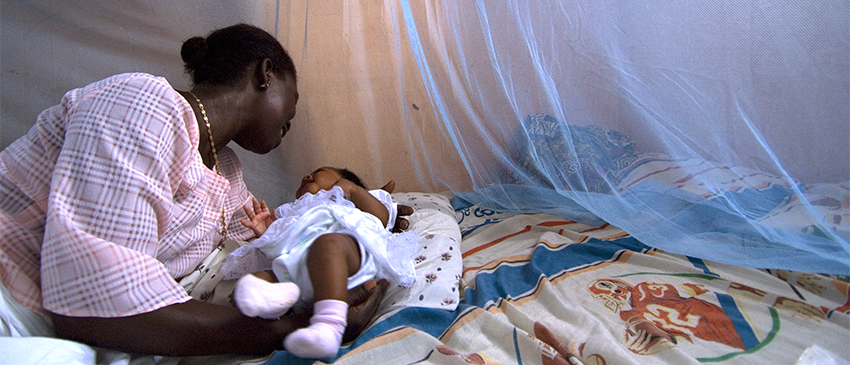
Gender and Malaria: The Overlooked (but Obvious) Connections
Malaria is the leading cause of morbidity and mortality in Uganda, which is estimated to have some of the highest numbers of malaria-related cases and deaths in Sub-Saharan Africa.[1] Malaria is estimated to account for 30–50 percent of health facility outpatient visits, 15–20 percent of hospital admissions, and 20 percent of hospital deaths.[2] Malaria transmission is endemic and perennial in 90–95 percent of the country.[3]
Gender equality is one of the most powerful social determinants of health risks, results, and outcomes. The relative decision-making power of women and men in a household determines whose health needs are met, and who can exercise control over their own health and well-being. Despite clear linkages between gender and health outcomes, many donor-funded malaria programs fail to consider how gender dynamics affect malaria exposure, prevention, diagnosis, and treatment. Instead, gender blind approaches to program implementation have been the norm.
Inequalities between women and men result in different levels of exposure and vulnerability to disease, different responses to ill-health, different health outcomes, and different consequences.
Banyan Global is addressing the overlooked but obvious connections between malaria and gender, as part of the United States Agency for International Development (USAID)-funded Malaria Action Program for Districts (MAPD) in Uganda. By examining the gender dynamics influencing how women, men, girls, and boys are vulnerable to malaria, and how they respond to illness, Banyan Global is providing the project with valuable information for malaria prevention and control.
The Malaria Action Program for Districts is leading support to the Government of Uganda’s National Malaria Reduction Strategic Plan (NMSP), working in 43 focus districts in partnership with the National Malaria Control Program at the Ministry of Health and District Health Management Teams (DHMTs). The project aims to: 1) implement effective malaria prevention programs; 2) implement effective malaria diagnosis and treatment activities; and 3) build capacity of NMSP and DHMTs to manage and sustain efficient malaria activities in focus districts.
In 2017, we conducted a qualitative gender analysis to identify how gender-related gaps, challenges, and constraints may hinder malaria treatment and prevention behaviors and activities. We found that women and children are more vulnerable to malaria infection, due to women’s high work burden in areas where mosquitos are prevalent. Demanding workloads can delay decisions to seek timely treatment for themselves or their children. Women can act to prevent or treat malaria only to the degree that their limited resources and decision-making power allow. As heads of households, men often control household resources. Decisions regarding mosquito net use, or where and when to access treatment or antenatal care, may be overridden by men, especially if resources are required. Women also bear the brunt of malaria’s impact. They are responsible for the care and treatment of ill family members, and can face domestic violence if they are perceived to be providing inadequate care or neglecting their household duties. Pervasive norms around masculinity often prevent men from practicing appropriate health-seeking behaviors. Men are less likely to view themselves as at risk of infection, less likely to seek timely treatment when they are ill, and more likely to self-medicate to save time and resources.
Banyan Global designed and delivered tailored, participatory gender integration training for 52 MAPD staff in March and April 2017. In one interactive exercise, participants examined the gendered division of labor in malaria prevention and treatment-related activities, exploring how this contrasts with household decision-making capacity around malaria. In another exercise, participants mapped key gender analysis findings across project components, to better understand how gender norms, roles, biases, and responsibilities could affect or be affected by project objectives and activities. Before training, only 13 percent of project staff felt they were familiar with gender considerations in malaria prevention and diagnosis; after training, 94 percent felt they could integrate gender into their ongoing work with government health workers and other stakeholders.
USAID’s Malaria Action Program for Districts will provide ongoing technical support and capacity-building to district health management teams, the National Malaria Control Program, and village health teams on ways to incorporate gender analysis findings into malaria prevention and control programming, policies, and interventions. The project’s gender team will also help implement specific social behavior change communication campaigns, focusing on promoting male engagement and participation in malaria prevention and diagnosis. Addressing the overlooked but obvious connections between gender and malaria will contribute to improved prevention and treatment, as well as positive behavior change, risk reduction, and more equitable outcomes.
[1] National Malaria Control Programme (NMCP). Uganda Malaria Reduction Strategic Plan 2014-2020. Kampala, Uganda; 2014; WHO. World Malaria Report 2016. Geneva: World Health Organization; 2016
[2] National Malaria Control Programme (NMCP). Uganda Malaria Reduction Strategic Plan 2014-2020. Kampala, Uganda; 2014.
[3] National Malaria Control Programme (NMCP). Uganda Malaria Reduction Strategic Plan 2014-2020. Kampala, Uganda; 2014.
